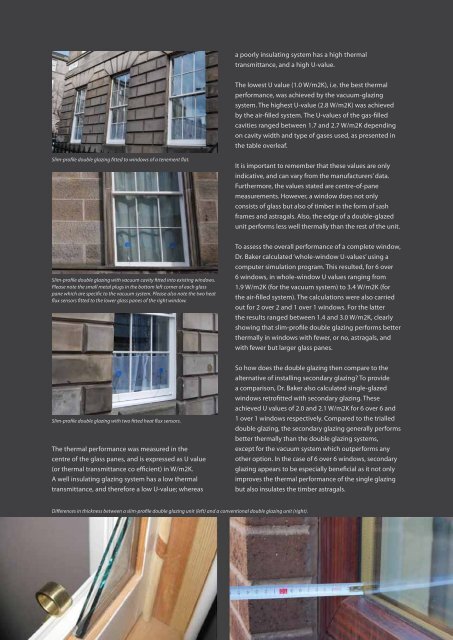informing the conservation of the built env ironment - Historic Scotland
informing the conservation of the built env ironment - Historic Scotland
informing the conservation of the built env ironment - Historic Scotland
Create successful ePaper yourself
Turn your PDF publications into a flip-book with our unique Google optimized e-Paper software.
a poorly insulating system has a high <strong>the</strong>rmal<br />
transmittance, and a high U-value.<br />
The lowest U value (1.0 W/m2K), i.e. <strong>the</strong> best <strong>the</strong>rmal<br />
performance, was achieved by <strong>the</strong> vacuum-glazing<br />
system. The highest U-value (2.8 W/m2K) was achieved<br />
by <strong>the</strong> air-filled system. The U-values <strong>of</strong> <strong>the</strong> gas-filled<br />
cavities ranged between 1.7 and 2.7 W/m2K depending<br />
on cavity width and type <strong>of</strong> gases used, as presented in<br />
<strong>the</strong> table overleaf.<br />
Slim-pr<strong>of</strong>ile double glazing fitted to windows <strong>of</strong> a tenement flat.<br />
It is important to remember that <strong>the</strong>se values are only<br />
indicative, and can vary from <strong>the</strong> manufacturers’ data.<br />
Fur<strong>the</strong>rmore, <strong>the</strong> values stated are centre-<strong>of</strong>-pane<br />
measurements. However, a window does not only<br />
consists <strong>of</strong> glass but also <strong>of</strong> timber in <strong>the</strong> form <strong>of</strong> sash<br />
frames and astragals. Also, <strong>the</strong> edge <strong>of</strong> a double-glazed<br />
unit performs less well <strong>the</strong>rmally than <strong>the</strong> rest <strong>of</strong> <strong>the</strong> unit.<br />
Slim-pr<strong>of</strong>ile double glazing with vacuum cavity fitted into existing windows.<br />
Please note <strong>the</strong> small metal plugs in <strong>the</strong> bottom left corner <strong>of</strong> each glass<br />
pane which are specific to <strong>the</strong> vacuum system. Please also note <strong>the</strong> two heat<br />
flux sensors fitted to <strong>the</strong> lower glass panes <strong>of</strong> <strong>the</strong> right window.<br />
To assess <strong>the</strong> overall performance <strong>of</strong> a complete window,<br />
Dr. Baker calculated ‘whole-window U-values’ using a<br />
computer simulation program. This resulted, for 6 over<br />
6 windows, in whole-window U values ranging from<br />
1.9 W/m2K (for <strong>the</strong> vacuum system) to 3.4 W/m2K (for<br />
<strong>the</strong> air-filled system). The calculations were also carried<br />
out for 2 over 2 and 1 over 1 windows. For <strong>the</strong> latter<br />
<strong>the</strong> results ranged between 1.4 and 3.0 W/m2K, clearly<br />
showing that slim-pr<strong>of</strong>ile double glazing performs better<br />
<strong>the</strong>rmally in windows with fewer, or no, astragals, and<br />
with fewer but larger glass panes.<br />
Slim-pr<strong>of</strong>ile double glazing with two fitted heat flux sensors.<br />
The <strong>the</strong>rmal performance was measured in <strong>the</strong><br />
centre <strong>of</strong> <strong>the</strong> glass panes, and is expressed as U value<br />
(or <strong>the</strong>rmal transmittance co efficient) in W/m2K.<br />
A well insulating glazing system has a low <strong>the</strong>rmal<br />
transmittance, and <strong>the</strong>refore a low U-value; whereas<br />
So how does <strong>the</strong> double glazing <strong>the</strong>n compare to <strong>the</strong><br />
alternative <strong>of</strong> installing secondary glazing? To provide<br />
a comparison, Dr. Baker also calculated single-glazed<br />
windows retr<strong>of</strong>itted with secondary glazing. These<br />
achieved U values <strong>of</strong> 2.0 and 2.1 W/m2K for 6 over 6 and<br />
1 over 1 windows respectively. Compared to <strong>the</strong> trialled<br />
double glazing, <strong>the</strong> secondary glazing generally performs<br />
better <strong>the</strong>rmally than <strong>the</strong> double glazing systems,<br />
except for <strong>the</strong> vacuum system which outperforms any<br />
o<strong>the</strong>r option. In <strong>the</strong> case <strong>of</strong> 6 over 6 windows, secondary<br />
glazing appears to be especially beneficial as it not only<br />
improves <strong>the</strong> <strong>the</strong>rmal performance <strong>of</strong> <strong>the</strong> single glazing<br />
but also insulates <strong>the</strong> timber astragals.<br />
Differences in thickness between a slim-pr<strong>of</strong>ile double glazing unit (left) and a conventional double glazing unit (right).











![Elgin Cathedral Wedding Brochure [pdf, 544kb] - Historic Scotland](https://img.yumpu.com/22301571/1/190x151/elgin-cathedral-wedding-brochure-pdf-544kb-historic-scotland.jpg?quality=85)




